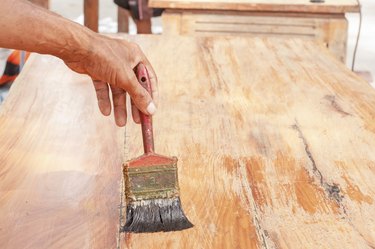
Lacquered furniture produced in the traditional way by Asian craftspeople is rare, so it's doubtful your lacquered furniture is of this vintage. Nevertheless, understanding the difference between traditional and modern lacquers can give even the novice an appreciation for this versatile finish and help you care for your lacquered furniture, no matter what type it is. Although lacquer is resilient, it's vulnerable to scratches, and modern lacquer finishes aren't as resistant to solvents as their ancient counterparts. Proper cleaning of lacquer furniture will help to maintain its beauty and value.
The Evolution of Lacquer
Video of the Day
The lacquer that ancient Japanese artisans used is called urushi. It comes from the sap of a tree related to the poison oak and ivy families, and they had to develop a resistance to the itching it causes before they could use it. They painted this material on in thin layers; each layer is cured by combining with moisture from the air.
Video of the Day
Modern lacquer, on the other hand, usually consists of a hardening material, such as cellulose or acrylic, in a solvent base. When the solvent dissolves, it leaves behind a coating that re-softens as soon as you add more solvent. Because modern lacquer doesn't cure, it's less resistant to liquids than traditional varieties.
Cleaning Lacquer Furniture by Wiping and Dusting
Whenever possible, cleaning lacquer furniture should begin with removing dust from a lacquered surface with a vacuum cleaner and an upholstery attachment with a soft brush, making minimal contact with the surface as you remove dust. When contact is required, use a soft, non-abrasive cloth.
To increase the ability of the cloth to attract dust, moisten it with water and wring it out so that it's damp, but not wet. Wipe lightly and dry immediately with another dry, soft cloth. Avoid paper towels. Although they feel soft in your hand, they actually form sharp edges that can scratch delicate lacquered surfaces. The scratches might not be noticeable at first, but as they accumulate, the finish gradually dulls.
Dealing with Spills
Most modern lacquers are somewhat water-resistant, but standing water quickly forms white spots as moisture seeps into the finish and clouds it. Prevent this by wiping water and juice spills as soon as they occur. Certain substances, including nail polish, nail polish remover and alcohol, may soften a lacquer finish.
When that happens, you only worsen the damage by removing the spill while the lacquer is wet. You may have to scrape or sand the spill off after it dries, but the procedure is easier and less messy than disturbing and cleaning lacquer furniture finishes while wet.
Repairing Minor Damage
If you inadvertently leave standing water on a lacquered surface -- or you put your hot coffee cup on it -- you can remove the resulting white mark by coating it with olive oil or mayonnaise, which contains vegetable oil. The oil seeps into the finish and displaces the water. After 12 to 24 hours, the white mark should be gone.
If you have to sand or scrape a dried spill, prepare the damaged area by smoothing it with 320-grit sandpaper and spray two or more repair coats of new lacquer with an aerosol can in a well-ventilated room. After the fresh lacquer dries, polish the surface with furniture polish.